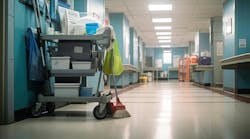Having properly cleaned and maintained facilities is a goal for every school and university, but achieving those high standards is becoming an insurmountable obstacle for custodial staffs decimated by budget constraints.
In a research paper compiled by the Minnesota Department of Health, “Cleaning, Indoor Environmental Quality and Health: A Review of the Scientific Literature,” the department notes the difficulty that education institutions in the state are having abiding by the standards they have set.
“Virtually every district that the Minnesota Department of Health has worked with in the past several years has reported cutting their maintenance budgets, including the numbers of custodians,” the department says. “Although many districts have good written cleaning guidelines, typically these guidelines are not implemented due to funding limitations, insufficient numbers of maintenance staff, or inadequate training of staff.”
The department recommends that schools have at minimum one custodian per 25,000 square feet of space. That ratio should be viewed as “the lower end for minimally adequate cleaning” and does not take into account the types of rooms and floor coverings.
“The amount of cleaning needed for a room depends on: the type of flooring; the number of hours it is used; the number of students; the amount of dust-collecting furnishings, materials, and clutter; and the presence of plants, animals, and activities,” the department says.
The paper notes that facilities management companies and professional associations recommend staffing guidelines of between 10,000 and 25,000 square feet per full-time custodian.
The health department recommends that school maintenance staffs carry out the following steps to improve their indoor environmental quality:
-
Floors should be cleaned daily, including all exposed surface areas.
-
Food-prep areas, tabletops, desktops, door handles and other frequent contact surfaces should be cleaned frequently, preferably daily.
-
Other surfaces — furniture, shelves, cupboard tops, window ledges, ventilation diffusers, storage areas — should also be cleaned periodically.
-
Custodians should use a micro-fiber cloth and HEPA filter vacuum for cleaning hard surfaces and carpet.
-
When replacing curtains and horizontal blinds, consider non-fleecy vertical blinds; if curtains must be used, use synthetic rather than natural fabrics.
-
Materials that can't be laundered should be dry cleaned, vacuumed or placed in a dryer on hot air or replaced with items that can be laundered.
Other staff members can help ease the burden on custodial workers:
-
Teachers should minimize clutter.
-
Staff should minimize fleecy items on display, such as stuffed toys, decorative items and hanging items. Fleecy toys that are routinely handled can collect skin cells, which are a primary food source for dust mites.
-
Second-hand furniture should not be permitted; these can be loaded with pet allergens and mold spores.
-
Students and staff can help custodians with cleaning by placing chairs on tables or stacking and placing trash cans in the hallway for pickup.
-
Eating in classrooms should be minimized, and teachers should clean food debris on surfaces.
-
Teachers should maintain animal habitats and properly care for plants.
NOTABLE
1
The recommended number of custodians per 25,000 square feet as a minimal staffing standard for schools.
Source: Minnesota Department of Health, “Cleaning, Indoor Environmental Quality and Health: A Review of the Scientific Literature”

